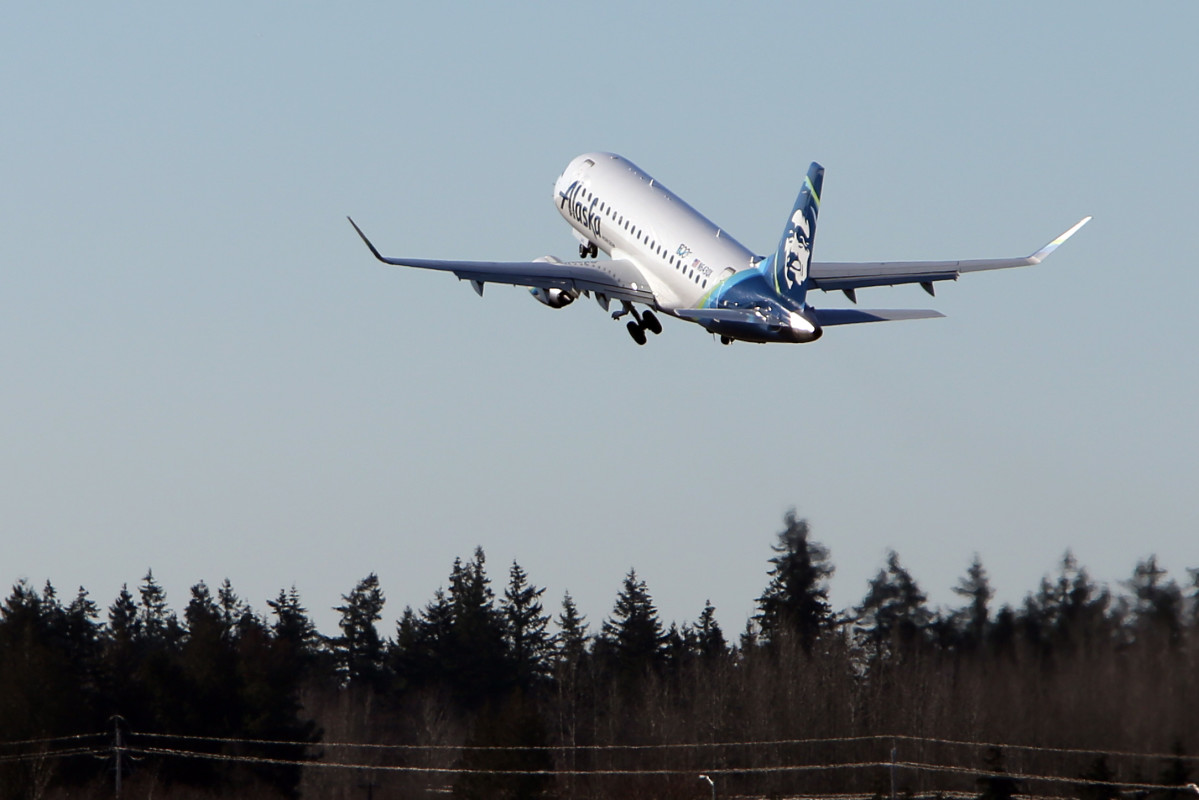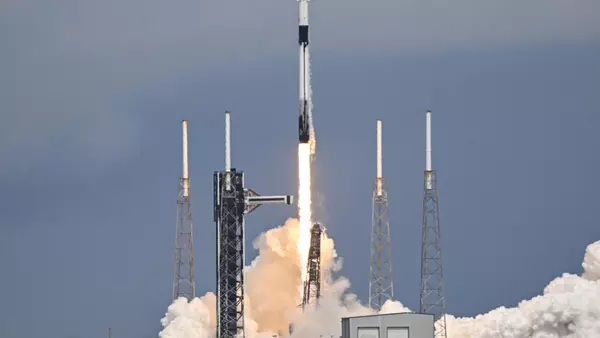
Luck was certainly on the side of the passengers of Alaska Airlines Flight 1282 — after all, no one was seated in the section of the aircraft where a piece of Boeing fuselage blew out, but credit should also go to its flight crew for quickly handling the emergency situation and landing with all 171 passengers and 6 crew members unharmed.
Just six minutes into a routine flight from Portland International Airport (PDX) to Southern California’s Ontario International Airport (ONT) on January 5, 2024, Flight 1282 was traveling at a speed of 400 mph and ascending to its cruising altitude of 33,000 feet. At 16,320 feet, just as the pilot gave the all-clear for passengers to use their cell phones, a loud explosion rocked the plane, filling the cabin with cold air and smoke.
Oxygen masks dropped in the quickly depressurizing aircraft; the force of air caused a deafening rush of wind that ripped off headrests and sucked cell phones out of passengers’ hands and into the refrigerator-sized hole.
The explosion also blew open the locked cockpit door, but the pilots remained calm, even though the noise was so loud they could not communicate with flight attendants and had to continuously repeat their messages to air traffic controllers. They skillfully turned the airplane around and executed an emergency landing in under 20 minutes, although their eye protection began fogging up on their final approach.
View the original article to see embedded media.
Pilots said they didn’t know what had happened to the aircraft at the time of the accident in their testimony to the National Transportation Safety Board, but soon the whole world would. The NTSB’s investigation revealed that a set of bolts behind the aircraft’s left wing that secured the fuselage in place had never been installed by Boeing mechanics.
NTSB Chair Jennifer Homendy said that had Flight 1282 stayed on course and reached its cruising altitude, the outcome would have been much more tragic.
Related: Boeing's turbulent descent: The company’s scandals & mishaps explained
At 33,000 feet in a depressurized cabin, the thin air would have caused passengers to lose consciousness within seconds, resulting in brain damage and then death.
“The actions of the flight crew were really incredible,” Homendy said.
What Is Alaska Airlines?
Not only are Alaska Airlines’ pilots exceptionally well trained — the airline recently invested in a $100 million training facility in Renton, Wash. — but all of its employees are guided by a shared spirit of integrity, caring, ingenuity, and professionalism that the company says stems from its Alaskan roots.
In such Arctic regions, airplanes are not only a critical method of transportation but also serve as a vital link between communities, delivering passengers, mail, and supplies to remote and isolated areas.
Alaska Airlines considers its 23,000 employees to be its greatest asset, which is a sentiment its customers would agree with, as the airline has been consecutively ranked among the top three airlines for customer service since 2008 by JD Power & Associates.
Alaska Airlines traces its beginnings to 1932, when two airlines, McGee Airways and Star Air Service, began operations in Anchorage. A few years later, McGee became a part of Star Air Service; in 1944, the company changed its name to Alaska Airlines and expanded service to include West Coast cities like Ketchikan, Alaska, Seattle, Wash., and across the Bering Strait to Magadan, Russia.
When the airline industry deregulated in 1979, Alaska Airlines expanded further, adding routes that encompassed the East Coast of the United States and south into Mexico. It also adopted a new logo, the smiling visage of a native Alaskan Inuk that embodied the Arctic peoples.
Today, Alaska Airlines has 23,000 employees and operates out of five West Coast hubs:
- Anchorage
- Los Angeles
- Portland, Ore.
- San Francisco
- Seattle/Tacoma
Its 3,000 pilots operate a fleet of 200 aircraft, including Boeing 737 series and Embraer 175 aircraft, flying to 115 destinations across the United States, Canada, Mexico, Costa Rica, and Belize.

Hispanolistic; Getty Images
How much do Alaska Airlines pilots make?
In 2022, Alaska Airlines was the first major airline to agree to salary hikes for its flight crew after the COVID-19 pandemic created massive cockpit shortages that increased the bargaining power of pilot unions.
Alaska Airlines’ pilot union, the Air Line Pilots Association (ALPA), approved a series of pay increases ranging from 15% and 23% for captains (depending on seniority), while first officers received increases between 8% and 23%.
In addition, a provision in the contract guaranteed future pay increases to stay competitive with other airlines, like United, American, and Southwest. This provision was enacted in 2023, giving pilots an additional 11.2% boost in wages.
More from airlines:
- American Airlines pilot salaries: How to land the world’s “dream job”
- Delta pilot salaries: What the world’s biggest airline pays its flightdeck
- Southwest Airlines pilot salaries: What the low-cost carrier pays its flight crew
That means, in just under two years, Alaska’s pilots are making up to 34.2% more money, which adds up to be quite a sum considering that even junior-level first officers start out with six-figure salaries.
How much do Alaska Airlines first officers make?
Alaska Airlines lists its starting pay for a first officer at a set rate of $100 per hour on its Careers page.
According to Thrust Flight, Alaska’s pilot pay differs from other airlines, like American Airlines and Delta, which compensate pilots based on type of aircraft flown and hours worked in a bidding period.
Thrust Flight used data from Alaska’s latest pilot contract to compile its pay ranges, breaking them down into the following:
| Experience | Salary |
|---|---|
Year 1 |
$107,846 |
Year 5 |
$200,000 |
Year 12 |
$225,800 |
Alaska Airlines’ first officers receive some of the industry’s highest entry-level wages. According to Epic Flight Academy, only American Airlines ($116,050), Delta Air Lines ($125,520), and Southwest Airlines ($133,000) pay their co-pilots more.
How much do Alaska Airlines captains make?
Alaska Airlines’ Careers page states that experienced Captains receive an hourly rate of $340.25.
Here’s how that works out per year:
| Experience | Salary |
|---|---|
Year 1 |
$312,000 |
Year 5 |
$322,000 |
Year 12 |
$340,000 |
According to data from Epic Flight Academy, this makes the salaries for Alaska Airlines’ Captains competitive with those at United Airlines ($352,000) while they lag behind bigger carriers like American Airlines ($469,550) and Delta Airlines ($447,240).
In addition, pilots who join Alaska Airlines through its Pathways Program with subsidiary Horizon Air are eligible for $12,500–$25,00 hiring bonuses based on the number of FAA-approved qualifying hours flown.
View the original article to see embedded media.
What benefits do Alaska Airlines pilots receive?
Alaska Airlines’ array of benefits goes above and beyond the typical medical and dental coverage and 401(k) retirement plans. The company offers the airline industry’s only goal-based incentive pay plan as well as paid time off, employee discounts at travel companies and retailers, career-long development programs including educational assistance and mentorship programs, and free travel privileges for employees and their families.
Related: Air traffic controller salary: What they make & how to become one
How do I become a pilot for Alaska Airlines?
Pilot candidates must be 23 years of age and have a valid U.S. passport and driver’s license. A college degree is preferred to work for the airlines, although not required.
Candidates need to demonstrate exceptional judgment, maturity, and leadership skills, and agree to relocate to San Francisco, Seattle, Los Angeles, Anchorage, Alaska, or Portland, Ore.
In terms of technical skills, candidates must pass the most current ATP written exam, have a minimum of 1,500 hours of total document flight time and a minimum of 500 hours of fixed-wing turbine time, and have a First Class FAA medical certificate and an FAA Commercial Pilot Certificate (Instrument/Airplane).
For those without flight experience, Alaska Airlines offers a career pathway through its Ascend Pilot Academy, which offers financial aid along with a stipend of up to $27,000.
Experienced pilots can continue their training at Horizon Air, Alaska’s subsidiary, where they then become certified first officers. Once they have completed 1,000 hours at Horizon, they are eligible to fly for Alaska Airlines.
Alaska Airlines is one of the few airlines actively hiring pilots. On its Careers page, open positions are listed for experienced first officers and its Pilot Development Program.
Related: Veteran fund manager sees world of pain coming for stocks







